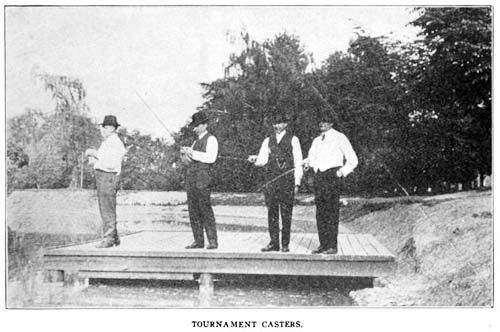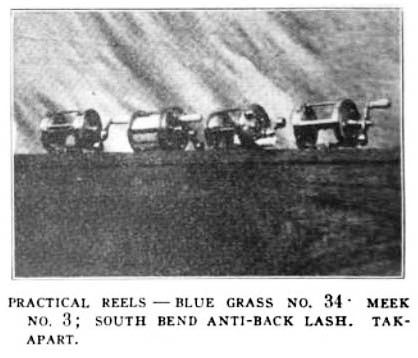The following article was published in the June 1917 Hunter-Trader-Trapper magazine. It's a great look at the state of bait casting at that time.
by
J.F. Atwood
Bait Casting is really a modern method of taking fish and as it has evolved into an art, even to some degree approaching that saintly method, fly fishing, one must be careful about claiming complete knowledge of the tools of the trade. Bass comes to the tongue in answer to the result obtained ordinarily, but not infrequently there floats before the mind's eye scenes in which the fighting musky and the tugging pike play the leading roles. In short today most bass, large and small mouth, muskellunge and pike, are caught by use of a free running reel and a casting rod.
All up-to-date shops that make any pretense of stocking fishermen's supplies, carry a selection of casting rods and reels and it is to aid the prospective purchaser or the beginner that this article is intended.
Many rods and reels are apparently made to sell rather than to use. It behooves the beginner or purchaser to study and familiarize himself with the advertised rods and reels offered to the sportsmen before attempting the selection. The quality being thus assured it is now up to the purchaser to be able to select the rod and reel most appropriate to the purpose for which it is intended.
Rods are offered at all prices, in all lengths of known and unknown makes. Some rods at a moderate price are real serviceable tools, while others are mere sticks apparently set up without thought by the maker that they were to be used to catch fish and were planned and builded according to no theory, at least, so far as evidenced by their usefulness.
A rod may be of wood or steel but it should have life, action and be so modeled and finished as to be a comfit and a pleasure to cast with. A trolling rod may be heavier and longer than a rod to cast a lure without inconvenience. In fact it is infinitely more pleasure to land a fish upon a long flexible rod and the fish is more easily played and held as it will be able to get the slack so necessary to have in order to throw the hook. The rod having more spring aids in tiring a large fish. It matters not so much if the fish be ordinary, as bait casters have a habit of starting him and keeping him coming until he is beached or in the boat.
Rods are made and sold of noibwood, greenheart, bethabara, lancewood, bamboo, an steel. The first named solid woods are not as serviceable nor useful as bamboo and are now almost entirely off the market, except in sea rods. These woods do not have the backbone or resilience of bamboo and. therefore, must be heavier and thus actionless to give the strength for real work. Some experimental chaps have made rods out of osage orange, ash, hickory and yew, but all these woods are apt to split and set quickly. The choice, therefore, narrows to the commonly advertised and used bamboo and steel rods.
Two pieces is the limit for split bamboo rods and, were it not for the inconvenience in carrying, a one piece rod is the real thine;. The Heddon type rods of long tip and short butt are the most practical of the two piece rods and the Whaling one piece rods are models of their kind. Five feet is short enough for any rod and the length depends somewhat upon the character of the fishing and the personal whims of the caster. For bank fishing and wading a five or fiver and one-half foot rod is best when the baits used are the regular plugs and lures. The lighter the lure and longer and lighter the rod is a good axiom. Action is necessity and the rod should be selected dependable upon the lure to cast. Tournament rods have a lot of action and are six feet in length on the average. Because of the number playing this game and through it the cultivation of the light tackle idea, there is a steady and growing demand for lighter rods. For a general purpose rod one as high as your eyes will generally fit. Pay as much for your rod as you can afford.

Steel rod manufacturers are making good actionable and serviceable rods that are built and have balance. The Bristol is a type that is high class and gives a good account whenever a strong and rugged tool is required. Steel is not bamboo for action nor is bamboo steel for strength.
For bait casting nothing but a good quality quadruple multiplier should be considered. Fair reels may be purchased from two dollars up but the lowest one should pay and expect the reel to give good service is five dollars and as much should be added to this as the pocketbook and war prices will permit.
The material best suited for reels is German silver. The frame should be strong and securely adjusted. It should be built so that it could be easily torn down for cleaning models of their kind. Five feet is short enough for any rod and the length depends somewhat upon the character of the fishing and the personal whim of the caster. For bank fishing and wading a five or five and one-half foot rod is best when the baits used are the regular plugs and lures. The lighter the lure the longer and lighter the rod is a good axiom. Action is a necessity and the rod should be selected dependable upon the lure to be cast. Tournament rods have a lot of action and are six feet in length on the average. Because of the number playing this game and through it the cultivation of the light tackle idea, there is a steady and growing demand for lighter rods. For a general purpose rod one as high as your eyes will generally fit. Pay as much for your rod as you can afford.

Steel rod manufacturers are making good actionable and serviceable rods that are built and have balance. The Bristol is a type that is high class and gives a good account whenever a strong and rugged tool is required. Steel is not bamboo for action nor is bamboo steel for strength.
For bait casting nothing but a good quality quadruple multiplier should be considered. Fair reels may be purchased from two dollars up but the lowest one should pay and expect the reel to give good service is five dollars and as much should be added to this as the pocketbook and war prices will permit.
The material best suited for reels is German silver. The frame should be strong and securely adjusted. It should be built so that it could be easily torn down for cleaning and the oil caps should be adjustable. The bearings should be tool steel and most high grade reels have jewels to prevent wear of the pinions. Jewels are not a necessity to free running as is shown in the Meek reels used by many fishermen and tournament casters. The click and drag are luxuries to the reel and not real component parts but when they are features they should be substantial.
A reel to give good service should spin freely. Accuracy helps catch fish and unless the spool responds readily accuracy is impossible. When testing reels to make a purchase ask the salesman to run a yard or two of wrapping cord on each reel. Hold the reel in the left hand and slowly start the spool. Test each spool in this manner and the aualitv will show. The start of the spool reflects or telegraphs the amount of friction overcome. A reel that will start easily will spin creel.
A general purpose bait casting reel should be large enough to hold not less than eighty yards of silk line. It may be necessary to put on a core or backing line, if it is then the casting will be made easier because of the increase of the diameter of the spindle of the spool. A long barreled spool casts easier. Standard reels such as Takeapart, Tripart, Meek and Bluegrass, South Bend Anti-Backlash and Shakespeare reels are examples of good general purpose reels.
Many reels on the market have spooling and anti-backlash features. When built as a part of the reel these additions are practical and useful to the beginner or the night caster. The South Bend Anti-Backlash reel is a practical reel of this type and has an adjustable anti-backlash device that may be adjusted to any desired tension or thrown off entirely after the owner has become proficient. The Gyratory reel is a recent addition to the market and has many good points that merits a trial.
Many fishermen prefer a free spool reel and they are universally used by tournament casters. They are a distinct advantage when casting light lures and spinners and will add feet to ordinary cast. Some of the Meek and Blue Grass reels are now made free spool and are unexcelled.
After all in reels and rods it is the quality of material and workmanship that counts. Most reels and rods are built upon the same general plan and the real difference is the carefulness of the adjustment and perfectness of material and construction. James Heddon's Sons of Dowagiac, Michigan, are to enter into the production of reels in the near future and claim the same carefulness of manufacture for their reels as they use in making their rods and baits.
Buy as good a reel and rod as you can. A high grade bait casting outfit is a joy forever. If you have never learned the game start now and what can be done with a good rod and reel will startle you. After a short trial you will become convinced that even the fish enjoy it because of the way they swash the plug, spinner and chunk.
-- Dr. Todd
No comments:
Post a Comment